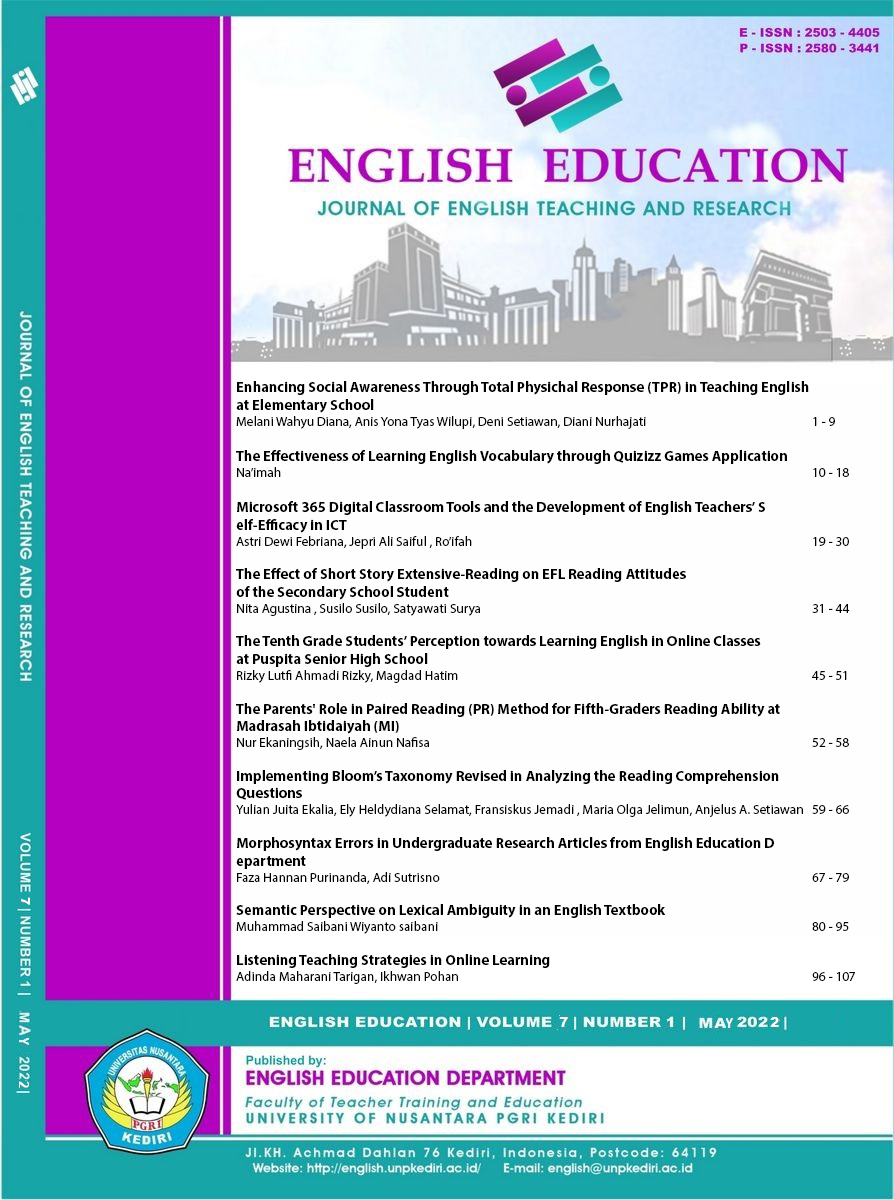The The Parents’ Role in Paired Reading (PR) Method for Fifth-Graders Reading Ability at Madrasah Ibtidaiyah (MI)
DOI:
https://doi.org/10.29407/jetar.v7i1.17163Keywords:
Parents’ Role, Paired Reading (PR) Method, Reading AbilityAbstract
The researcher’s goal is to elaborate in detail on the parents’ role and explain the steps of parents’ role in the Paired Reading (PR) method for fifth-graders reading ability. The researcher carried out the qualitative approach, which describes the data after observations. A total of five parents were involved in this research as a participant. Data were collected by using interviews on Whatsapp with ten questions for each parent as a participant in this research. The findings indicated that parents have a crucial role in assisting their children in improving their reading ability. They played their role as teachers, motivators, and facilitators. Parents acted as a teacher to provide examples of correct pronunciation. Then, working as a motivator to motivate their children in English reading was fun and useful. Finally, parents acted as a facilitator by providing a comfortable learning environment. Therefore, parents’ role in the Paired Reading (PR) method is considered effective in improving children reading ability.
Keywords:Parents’ Role, Paired Reading (PR) Method, Reading Ability
Downloads
References
Agustina, F. (2016). The Effectiveness of Using Four Square Writing Method in Teaching Writing Narrative Text at the Tenth Grade of SMA N 1 Purworejo in the Academic Year of 2015/2016. http://repository.umpwr.ac.id:8080/handle/123456789/2267
Anney, V. N. (2014). Ensuring the quality of the findings of qualitative research: looking at trustworthiness criteria. Journal of Emerging Trends in Educational Research and Policy Studies, 5(2), 272–281. http://hdl.handle.net/123456789/256
Ardiana. (2015). Improving the Students Reading Comprehension in. Exposure Journal, 4(2 November 2015), 37–44. https://doi.org/10.26618/exposure.v4i2.923
Libakova, N. M., & Sertakova, E. A. (2015). The Method of Expert Interview as an Effective Research Procedure of Studying the Indigenous Peoples of the North. Journal of Siberian Federal University. Humanities & Social Sciences, 1(2015 8), 114–129. https://doi.org/10.17516/1997-1370-2015-8-1-114-129
Lumuan, muhammad haeril. (2015). Penerapan Paired Reading Model Dalam Meningkatkan Kemampuan Reading Comprehension Pada Report Text Siswa Guru Bahasa Inggris SMAN 1 Peling Tengah Kabupaten Banggai Kepulauan Muhammad Haeril Lumuan , 49–55. https://media.neliti.com/media/publications/123777-ID-penerapan-paired-reading-model-dalam-men.pdf
Mwangi, J. (2018). Parental Involvement in Reading: Does Involvement Translate To Performance in Kiswahili Comprehension Among Elementary School Pupils in, Kenya? International Journal of Scientific and Education Research, 2(02), 67–84.
Mwoma, T. (2017). Children’s reading ability in early primary schooling: Challenges for a Kenyan rural community. Issues in Educational Research, 27(2), 347–364.
Ospina, S. (2004). Qualitative Research.
Rini, Puspa; Ekaningsih, N. (2020). Reading Descriptive Text Comprehension Improvement by Jigsaw Teaching Technique. POMINENT Journal, 3(1), 244–253. https://doi.org/https://doi.org/10.24176/pro.v3i1.4671
Robinson, H. C. (2011). Chapter Iii. Diary, Reminiscences and Correspondence, 84–117. https://doi.org/10.1017/cbo9780511791796.003
Sugiyono. (2015). Bab III Metode Penelitian Jenis. Hilos Tensados, 1, 1–476.
Triana, N. (2019). Penerapan Metode Paired Reading/ Paired Summarizing Untuk Meningkatkan Kemampuan Pemahaman Membaca Teks Pada Siswa Smk Abdurrab Pekanbaru. Inteligensi : Jurnal Ilmu Pendidikan, 2(1), 33–38. https://doi.org/10.33366/ilg.v2i1.1498
Vasylenko, O. V. (2017). The Parents’ role in helping children to develop reading skills. Eetp, 12(4), 71–80. https://doi.org/10.14632/eetp.2017.12.46.71
Downloads
Published
Issue
Section
License
Authors who publish with this journal agree to the following terms:
- Copyright on any article is retained by the author(s).
- The author grants the journal, the right of first publication with the work simultaneously licensed under a Creative Commons Attribution License that allows others to share the work with an acknowledgment of the work’s authorship and initial publication in this journal.
- Authors are able to enter into separate, additional contractual arrangements for the non-exclusive distribution of the journal’s published version of the work (e.g., post it to an institutional repository or publish it in a book), with an acknowledgment of its initial publication in this journal.
- Authors are permitted and encouraged to post their work online (e.g., in institutional repositories or on their website) prior to and during the submission process, as it can lead to productive exchanges, as well as earlier and greater citation of published work.
- The article and any associated published material is distributed under the Creative Commons Attribution-ShareAlike 4.0 International License








 Article template
Article template



